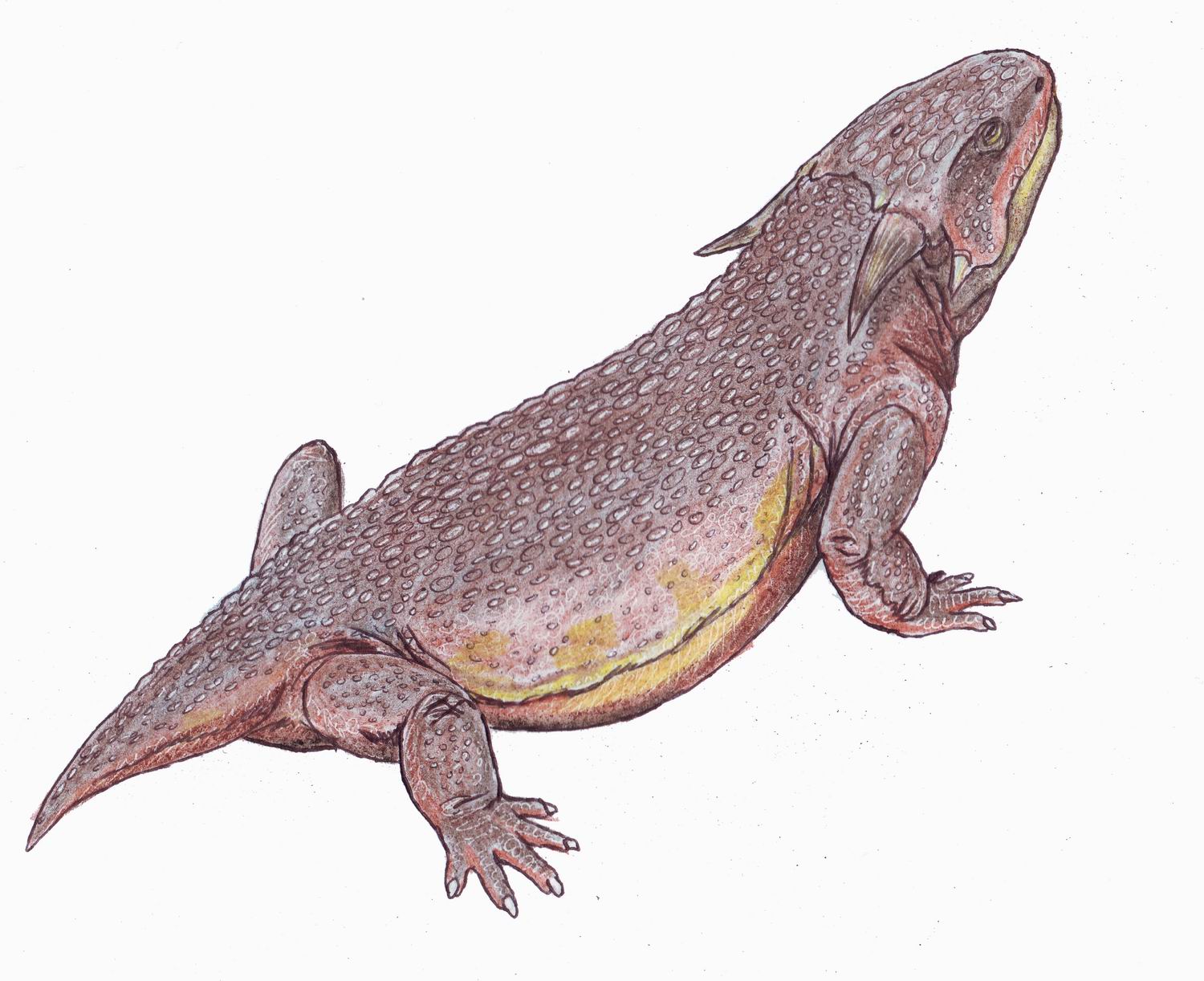- Procolophonia
Taxobox
name = "Procolophonia"
fossil_range =Permian toTriassic (if incl. Turtles then Permian to Recent)

image_width = 250px
image_caption = "Sclerosaurus ".
regnum =Animal ia
phylum =Chordata
subphylum =Vertebrata
superclassis =Tetrapoda
classis =Sauropsida /Reptilia
subclassis =Parareptilia
ordo =Procolophonomorpha
subordo = Procolophonia
subordo_authority = Seeley,1888
subdivision_ranks = Families
subdivision = Procolophonoidea
:Owenettidae
:Procolophonidae
:?Sclerosauridae
Pareiasauroidea
:?Rhipaeosauridae
:Pareiasaur idaeThe Procolophonia are an suborder of herbivorousreptile s that lived from the Middle Permian till the end of the Triassic period. They were originally included as a suborder of theCotylosauria (later renamedCaptorhinida Carroll 1988) but are now considered a clade ofParareptilia . They are closely related to other generally lizard-like Permian reptiles such as theMillerettidae ,Bolosauridae ,Acleistorhinidae ,Lanthanosuchidae , andNyctiphruretidae , all of which are included under theAnapsida or "Parareptiles" (as opposed to theEureptilia ).Subclassification
There are two main groups of Procolophonia, the small, lizard-like
Procolophonoid ea, and the "Pareiasauroidea", which include the large, armouredPareiasaur idae. Smaller groups likeRhipaeosauridae and Sclerosauridae might be placed in either superfamily, or prior to both, although according to the traditional classifification of Carroll 1988 the Rhipaeosauridae are classified with the Pareiasaurs and the Sclerosaurs with the Procolophonids.Relation to Turtles
The Procolophonia are traditionally thought to be ancestral to the Turtles, although experts disagree over whether turtle ancestors are to be sought among the Procolophnidae, the Pareiasauridae (Lee 1995,1996, 1997), or simply a generic Procolophnian ancestor. Laurin & Reisz, 1995 and Laurin & Gauthier 1996 define the Procolophonia cladistically as "The most recent common ancestor of pareiasaurs, procolophonids, and testudines (Chelonia), and all its descendants", and list a number of autapomorphies. However, Rieppel and deBraga 1996 and deBraga & Rieppel, 1997 argue that turtles evolved from
Sauropterygia ns, which would mean that the Parareptilia and Procolophonia constitute wholly extinct clades that are only distantly related to living reptiles.References
* Carroll, R. L., (1988), "
Vertebrate Paleontology and Evolution " (incl. Appendix; Vertebrate Classification), W.H. Freeman & Co. New York
* deBraga M. & O. Rieppel. 1997. Reptile phylogeny and the interrelationships of turtles. Zoological Journal of the Linnean Society 120: 281-354.
* Kuhn, O, 1969, Cotylosauria, part 6 of "Handbuch der Palaoherpetologie" (Encyclopedia of Palaeoherpetology ),Gustav Fischer Verlag , Stuttgart & Portland
* Laurin, M., & Gauthier, J. A., 1996 [http://tolweb.org/articles/?article_id=462 Phylogeny and Classification of Amniotes] , at theTree of Life Web Project
* Laurin, M. & R. R. Reisz. 1995. A reevaluation of early amniote phylogeny.Zoological Journal of the Linnean Society 113: 165-223.
* Lee, M. S. Y. 1995. Historical burden in systematics and the interrelationships of 'Parareptiles'. Biological Reviews of the Cambridge Philosophical Society 70: 459-547.
* Lee M. S. Y. 1996. Correlated progression and the origin of turtles. Nature 379: 812-815.
* Lee, M. S. Y., 1997: Pareiasaur phylogeny and the origin of turtles.Zoological Journal of the Linnean Society : Vol. 120, pp. 197-280
* Rieppel O. & M. deBraga. 1996. Turtles as diapsid reptiles. Nature 384: 453-455.External links
* [http://www.fmnh.helsinki.fi/users/haaramo/Metazoa/Deuterostoma/Chordata/Reptilia/Parareptilia/Hallucicrania.htm Hallucicrania] -
Mikko's Phylogeny Archive
* [http://www.palaeos.com/Vertebrates/Units/Unit200/100.html Basal Anapsids] -Palaeos
Wikimedia Foundation. 2010.
